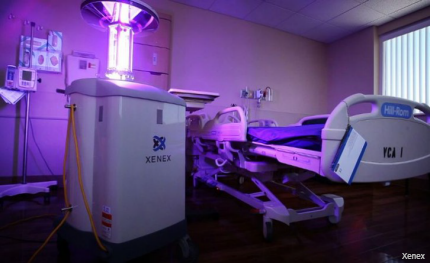Air Force hospital adds Ebola-zapping robot
The Xenex system uses xenon ultraviolet light to rid rooms of a full range of viruses.

Geri Genant of Xenex, left, demonstrates Saul, working in the next room, at U.S. Air Force Hospital Langley.
An Air Force hospital has taken delivery of a robot that could do a lot to prevent the spread of viruses like Ebola—a system that uses pulses of xenon ultraviolet light to destroy viruses that are left in a room where a patient has been treated.
The 633rd Medical Group at U.S. Air Force Hospital Langley, amid heightened concerns of Ebola in the United States and on the heels of a White House executive order on confronting the disease, became the first Air Force hospital to acquire the cutting-edge technology, according to an Air Force release.
Made by Xenex and nicknamed Saul, the 5-foot, 2-inch robot—which sort of resembles R2D2 with a bug-zapper atop it—uses the full germicidal UV spectrum and generates pulses 25,000 times brighter than those of a florescent light to crack open the cell walls of bacteria and kill pathogens inside, according to Geri Genant, Xenex Healthcare Services’ implementation manager, who demonstrated Saul to hospital staff. And it can do it in five minutes.
The process is an additional step to established cleaning and disinfection and is intended to protect both hospital staff and patients from serious infectious diseases. After a patient with Ebola or another virulent disease is treated, hospital staff outfitted in protective gear thoroughly go over the room with cleaning chemicals. But viruses and bacteria can remain in hard-to-reach places and other areas. The robot can then enter the room and disinfect every surface in five minutes—and destroy Ebola-like viruses in two minutes, according to the company.

"Xenex has tested its full-spectrum disinfection system on 22 microorganisms, studying nearly 2,000 samples in several independent labs all over the world," Genant said in the release. She said hospital that have used the system have seen their rates of infection fall as much as 60 percent. (In general, what are called HAIs, for healthcare associated infections, affect roughly one in 20 patients.)
Ebola doesn’t spread through the air, but though contact with bodily fluids or objects, such as needles, that have been exposed to the virus. The Centers for Disease Control and Prevention has said that, under optimum conditions, Ebola can survive on surfaces for up to six days. In a study of ways to counter the virus, CDC also found that it is very sensitive to ultraviolet light.
Ultraviolet light has been emerging as a room disinfectant option. Light generated by mercury bulbs have been used for years for air and water purification and companies are now producing systems for room disinfection. But they do carry a risk because they contain elemental mercury, which is classified as toxic, Xenex says. Xenex uses xenon, an inert gas, and works more quickly than mercury bulbs. It’s also the only full-spectrum UV disinfectant.
The Ebola epidemic that has raged in West Africa, coupled with a few domestic cases, has raised concern over the ability for hospitals to keep patients and staff members safe during an outbreak. A robot like Saul seems a likely way to help prevent hospital infections. Presumably, it also could be used in the home of someone who has developed symptoms.




